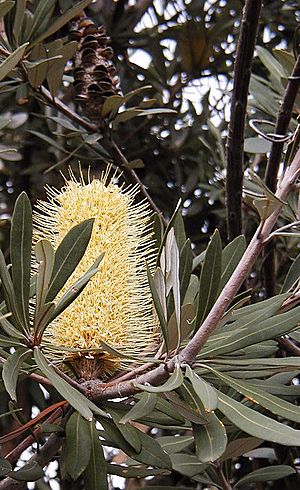Banksia ser. Salicinae facts for kids
Quick facts for kids Banksia ser. Salicinae |
|
|---|---|
 |
|
| B. integrifolia (Coast Banksia), a type of B. ser. Salicinae | |
| Scientific classification | |
| Kingdom: | |
| (unranked): | |
| (unranked): | |
| Order: | |
| Family: | |
| Genus: | |
| Series: |
B. ser. Salicinae
Meisn.
|
Banksia ser. Salicinae is a scientific name used to group certain types of Banksia plants. Think of a "series" as a smaller group within a larger plant family. This name was first used by a scientist named Carl Meissner in 1856. Over time, different scientists have changed how they define which plants belong to this group.
Contents
Understanding Banksia Plant Groups
Meissner's First Grouping (1856)
In 1856, Carl Meissner wrote about the Proteaceae plant family. He created the group B. ser. Salicinae. He divided a larger group called Eubanksia into four smaller series. Meissner decided which plants belonged to Salicinae based on their leaves. Plants in this series had long, narrow leaves with fuzzy, grey undersides. Because he only looked at leaves, his groups often contained very different types of plants.
Here are a few examples of plants Meissner included in B. ser. Salicinae:
- B. cunninghamii (now B. spinulosa var. cunninghamii)
- B. occidentalis
- B. littoralis
- B. integrifolia
- B. marginata
Meissner's way of grouping Banksia plants was used until 1870. Then, another scientist named George Bentham created his own system. He decided not to use any of Meissner's series.
George's New Grouping (1981)
In 1981, Alex George published a major study on Banksia. He brought back the name B. ser. Salicinae. This time, he placed it within a group called B. sect. Banksia. George defined this series differently. He included species with leaves that were either smooth, saw-edged, or toothed. He also looked at the plant's pollen-presenter (a part of the flower) and its follicles (seed pods). The follicles in this group had no beak-like tip.
Here are some of the plants George included in B. ser. Salicinae:
- B. dentata
- B. aquilonia
- B. integrifolia (which has different subspecies)
- B. plagiocarpa
- B. robur
- B. marginata
Later, George accidentally called this series B. ser. Banksiae in another book. But that name was not officially accepted. In 1991, a fossil plant from Tasmania, B. kingii, was also placed in this series.
Thiele and Ladiges' Analysis (1996)
In 1996, scientists Kevin Thiele and Pauline Ladiges studied Banksia using a method called cladistics. This method looks at how different features of plants are related to each other. Their study showed a slightly different family tree for Banksia than George's.
They found that George's B. ser. Salicinae group was a "monophyletic" group. This means all the plants in it came from a single common ancestor. They kept George's B. ser. Salicinae but divided it even further. They created two smaller groups called subseries: B. subser. Acclives and B. subser. Integrifoliae.
Here's how they organized B. ser. Salicinae:
- B. ser. Salicinae
- B. subser. Acclives
- B. subser. Integrifoliae
- B. marginata
- B. conferta
- B. conferta subsp. penicillata
- B. paludosa
- B. canei
- B. saxicola
- B. integrifolia (with its subspecies)
- B. integrifolia subsp. aquilonia (now B. aquilonia)
Thiele and Ladiges' system was used for a short time. In 1999, Alex George published another major work on Banksia. He went back to his 1981 system but made some small updates based on new information.
New Discoveries (Since 1998)
Since 1998, scientist Austin Mast has been studying Banksia using DNA information. His studies suggest a very different family tree for Banksia. He found that the Banksia group might not be a single, complete group by itself. It might be mixed with another group called Dryandra.
Mast's studies showed that B. ser. Salicinae is mostly a "monophyletic" group, meaning its members are closely related. However, the exact relationships within the group are still being figured out.
In 2007, Mast and Thiele started to rearrange Banksia again. They moved Dryandra plants into the Banksia group. They also created new subgenera (larger groups) based on the shape of the plants' first leaves (called cotyledons). They plan to publish a full new arrangement once they finish studying all the DNA.
Where Banksia Salicinae Grow
Most species in B. ser. Salicinae are found only along the east coast of Australia. There is one special exception: B. dentata, also known as the Tropical Banksia. This plant grows across northern Australia, including the Kimberleys. It is also found in New Guinea and the Aru Islands.
How They Mix: Hybridization
Sometimes, different species of Banksia can interbreed in the wild. This is called hybridization. It has been seen happening between many members of the Salicinae series, including:
- B. paludosa and B. integrifolia
- B. marginata and B. integrifolia
- B. robur and B. oblongifolia
- B. marginata and B. conferta subsp. penicillata
- B. conferta subsp. conferta and B. integrifolia
See also
 In Spanish: Banksia ser. Salicinae para niños
In Spanish: Banksia ser. Salicinae para niños

